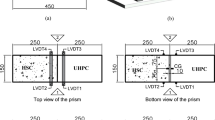Abstract
To obtain a more robust understanding of the effects of temperature on crack widths, stiffness, strength and short term creep behaviour of reinforced concrete elements to improve structural assessment techniques. Crack widths are monitored in four small scale reinforced concrete tension specimens, while exposed to temperature cycles. Four large scale beams, two at room temperature and two at −20 °C, are loaded under four point bending for 48 h at service load before being tested to failure. Crack width behaviour and mid-span deflections are monitored. A comparison of the room temperature and low temperature test results show that the crack widths tend to decrease at lower temperatures in members that are free to expand and contract. The beams also saw an increase in strength that was dependent on the failure mode, but saw no noticeable increase in stiffness. Lastly, short-term creep behaviour was reduced in the low temperature beams. The observed cracking behaviour and beam test results indicate the potential for an increase in shear capacity for beams at lower temperatures.















Similar content being viewed by others
References
ACI Committee 224 (2001) Control of cracking in concrete structures ACI-224R-01. ACI, Farmington Hills
Baumert ME (1995) Low temperature behaviour of reinforced concrete beams strengthened with CFRP sheets. M.Sc. dissertation, Queen’s University, Kingston
Bisby L, Take WA, Caspary A (2007) Quantifying strain variation in FRP confined concrete using digital image correlation: proof of concept and initial results. Asia Pac Conf FRP Struct 1–2:599–604
Browne RD, Bamforth PB (1981) The use of concrete for cryogenic storage: a summary of research, past and present. In: Cryogenic concrete: proceedings of the 1st international conference. The Concrete Society, London, pp 135–166
CSA (2006) CSA Standard A23.3-04: design of concrete structures. Canadian Standards Association, Toronto
Collins MP, Mitchell D (1997) Prestressed concrete structures. Response Publications, Toronto
DeRosa D (2012) Thermal effects on monitoring and performance of reinforced concrete structures. MASc dissertation, Queen’s University, Kingston
Dutton M (2012) Digital image correlation for evaluating structural engineering materials. MASc dissertation, Queen’s University, Kingston
Hoult NA, Take WA, Lee C, Dutton M (2013) Experimental accuracy of two dimensional strain measurements using digital image correlation. Eng Struct 46:718–726
Johansen R, Best CH (1962) Creep of concrete with and without ice in the system. RILEM Bull 16:47–57
Lee C, Take WA, Hoult NA (2012) Optimum accuracy of two dimensional strain measurements using digital image correlation. J Comput Civil Eng 26(6):795–803
Ma S, Pang J, Ma Q (2012) The systematic error in digital image correlation induced by self-heating of a digital camera. Meas Sci Technol 23(2):7
Marshall AL (1982) Cryogenic concrete. Cryogenics 22(11):555–565
Miura T (1989) The properties of concrete at very low temperatures. Mater Struct 22(4):243–254
Neville AM (2006) Properties of concrete, 4th edn. Pearson Prentice Hall, Toronto
Sutton MA, Oreu JJ, Schreier HW (2009) Image correlation for shape, motion and deformation measurements. Springer Science + Business Media, New York
Thusyanthan NI, Take WA, Madabhushi SPG, Bolton MD (2007) Crack initiation in clay observed in beam bending. Geotéchnique 57(7):581–594
Vecchio FJ, Collins MP (1986) The modified compression field theory for reinforced concrete elements subjected to shear. J Am Concr Inst 83(2):219–231
Walraven JC (1981) Fundamental analysis of aggregate interlock. ASCE J Struct Div 107:2245–2270
White DJ, Take WA, Bolton MD (2003) Soil deformation measurement using particle image velocimetry (PIV) and photogrammetry. Géotechnique 50(7):619–631
Yamane S, Kasami H, Okuno T (1978) Properties of concrete at very low temperatures. Int Symp Concr Concr Struct ACI SP 55:207–221
Acknowledgments
The authors gratefully acknowledge the financial support of the Natural Science and Engineering Research Council of Canada. The authors would also like to thank Mike Dutton, Keelin Scully, Ryan Regier, and Paul Thrasher for their assistance with this research.
Author information
Authors and Affiliations
Corresponding author
Rights and permissions
About this article
Cite this article
DeRosa, D., Hoult, N.A. & Green, M.F. Effects of varying temperature on the performance of reinforced concrete. Mater Struct 48, 1109–1123 (2015). https://doi.org/10.1617/s11527-013-0218-y
Received:
Accepted:
Published:
Issue Date:
DOI: https://doi.org/10.1617/s11527-013-0218-y




